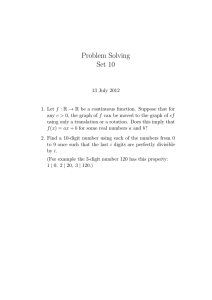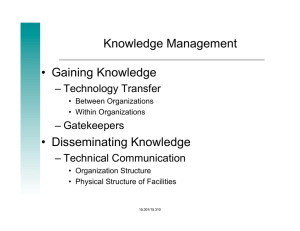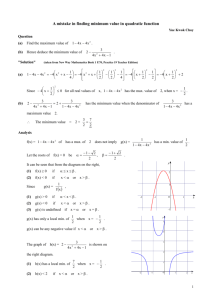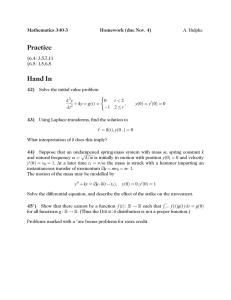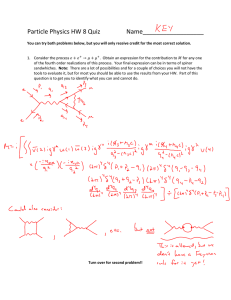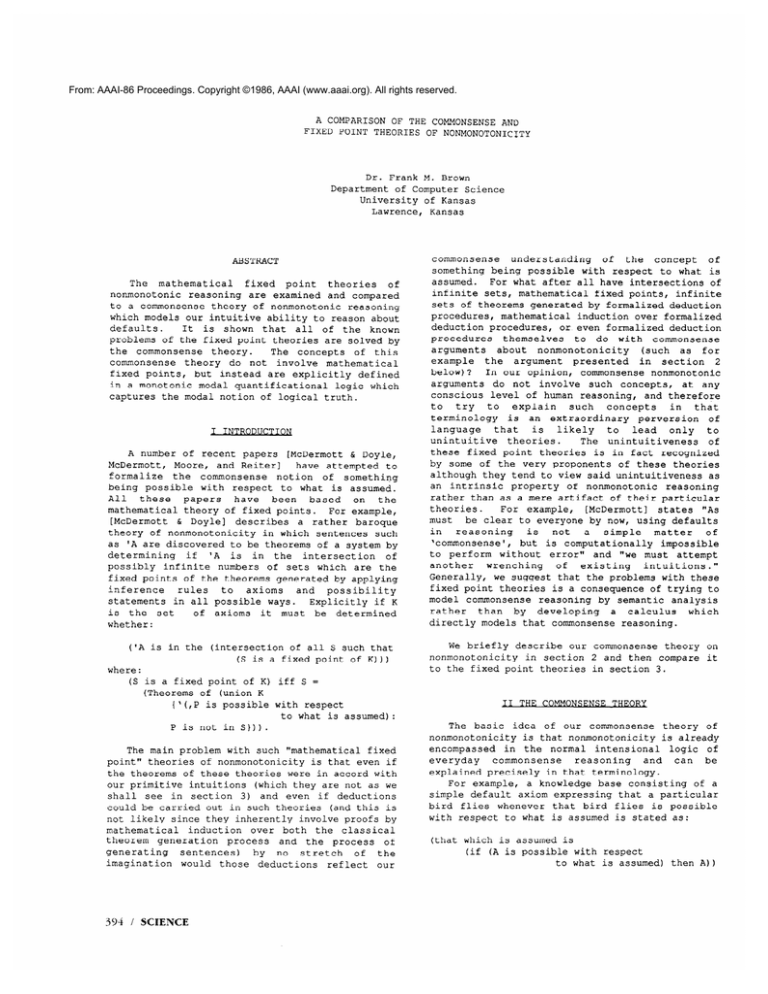
From: AAAI-86 Proceedings. Copyright ©1986, AAAI (www.aaai.org). All rights reserved.
A COMPARISON
OF THE COMMONSENSE
AND
FIXED POINT THEORIES OF NONMONOTONICITY
Dr. Frank M. Brown
Department
of Computer SC ience
University
of Kansas
Lawrence
Kansas
ABSTRACT
The
mathematical
fixed
point
theories
of
nonmonotonic
reasoning
are examined
and compared
to a commonsense
theory of nonmonotonic
reasoning
which models our intuitive ability to reason about
defaults.
It is shown
that all of the known
problems of the fixed point theories are solved by
the commonsense
theory.
The concepts
of this
commonsense
theory
do not involve
mathematical
fixed points,
but instead are explicitly
defined
in a monotonic
modal quantificational
logic which
captures the modal notion of logical truth.
IINTRODUCTION
A number of recent papers
[McDermott & Doyle,
McDermott,
Moore, and Reiter]
have attempted
to
formalize
the commonsense
notion
of something
being possible
with respect to what is assumed.
All
these
papers
have
been
based
on
the
mathematical
theory of fixed points.
For example,
[McDermott
& Doyle]
describes
a rather baroque
theory of nonmonotonicity
in which sentences
such
as 'A are discovered
to be theorems of a system by
determining
if
'A is in the
intersection
of
possibly
infinite
numbers
of sets which are the
fixed points of the theorems generated by applying
inference
rules
to
axioms
and
possibility
statements
in all possible
ways.
Explicitly
if K
is the set
of axioms
it must
be determined
whether:
('A is in the
(intersection
of all S such that
(S is a fixed point of K)))
where:
(S is a fixed point of K) iff S =
(Theorems of (union K
{'(,P is possible with respect
to what is assumed):
P is not in S})).
The main problem with such "mathematical
fixed
point" theories of nonmonotonicity
is that even if
the theorems of these theories were in accord with
our primitive
intuitions
(which they are not as we
shall see in section
3) and even if deductions
could be carried out in such theories
(and this is
not likely since they inherently
involve proofs by
mathematical
induction
over both the classical
theorem
generation
process
and the process
of
generating
sentences)
by
no
stretch
of
the
imagination
would
those
deductions
reflect
our
394 / SCIENCE
commonsense
understanding
of the
concept
of
something
being possible
with respect to what is
assumed.
For what after all have intersections
of
infinite sets, mathematical
fixed points, infinite
sets of theorems generated by formalized deduction
procedures,
mathematical
induction over formalized
deduction procedures,
or even formalized deduction
procedures
themselves
to do with
commonsense
arguments
about
nonmonotonicity
(such
as for
example
the
argument
presented
in section
2
below)?
In our opinion, commonsense
nonmonotonic
arguments
do not involve
such concepts,
at any
conscious
level of human reasoning,
and therefore
to
try
to
explain
such
concepts
in
that
terminology
is an extraordinary
perversion
of
language
that
is
likely
to
lead
only
to
unintuitive
theories.
The unintuitiveness
of
these fixed point theories
is in fact recognized
by some of the very proponents
of these theories
although they tend to view said unintuitiveness
as
an intrinsic
property
of nonmonotonic
reasoning
rather than as a mere artifact of their particular
theories.
For example,
[McDermott]
states
"AS
must
be clear to everyone by now, using defaults
in
reasoning
is
not
a
simple
matter
of
'commonsense',
but is computationally
impossible
to perform
without
error"
and "we must attempt
another
wrenching
of
existing
intuitions."
Generally,
we suggest that the problems with these
fixed point theories is a consequence
of trying to
model commonsense
reasoning
by semantic
analysis
rather
than
by
developing
a calculus
which
directly models that commonsense
reasoning.
We briefly describe
our commonsense
theory
nonmonotonicity
in section 2 and then compare
to the fixed point theories in section 3.
II
on
it
THE CO-
The basic
idea of our commonsense
theory
of
nonmonotonicity
is that nonmonotonicity
is already
encompassed
in the normal
intensional
logic of
everyday
commonsense
reasoning
and
can
be
explained precisely
in that terminology.
For example,
a knowledge
base consisting
of a
simple default axiom expressing
that a particular
bird flies whenever
that bird flies is possible
with respect to what is assumed is stated as:
(that which is assumed is
(if (A is possible with respect
to what is assumed)
then A))
where
A stands
for the proposition
that that
particular
bird flies.
Reflection
on
the
meaning
of
this
knowledgebase
leads immediately
to the conclusion
that
either
A is logically
possible
and the
knowledgebase
is synonymous
to A, or A is not
logically
possible
and
the
knowledgebase
is
synonymous
to logical truth.
This conclusion
is
obtained by simple case analysis:
for either A is
possible with respect to what is assumed or it is
If A is possible
with respect
to what is
not.
assumed then, since (if truth then A) is just
A,
that which is assumed
is indeed A.
Since that
which is assumed is A, A is possible with respect
to what
is assumed
only
if A is
logically
On the other hand, if A is not possible
possible.
with respect to what is assumed then since falsity
implies A is just truth, that which is assumed is
truth.
Since that which is assumed is truth, A is
not possible
with respect to what is assumed only
if A is not logically
possible.
Thus if it is
further assumed that A is logically possible, then
it follows that the knowledgebase
is synonymous to
A itself.
The nonmonotonic
nature
of these
expressions
becomes
apparent
if an additional
proposition
that that particular
bird does not fly
is added to the knowledgebase:
(that which is assumed is
(and (not A)
(if (A is possible with respect
to what is assumed)
then A)))
Reflection
on this new knowledgebase
leads
immediately
to
the
conclusion
that
it
is
synonymous
to not A.
This conclusion
is again
by
simple
case analysis:
obtained
for if A is
possible
with respect
to what is assumed
then,
since (if truth then A) is just A, that which is
assumed is indeed ((not A)and A) which is falsity.
Since
that
which
is assumed
is falsity
A is
possible with respect to what is assumed only if A
and falsity is logically possible which it is not.
Thus A is not possible
with respect to what is
assumed.
On the other hand, if A is not possible
with
respect
to what
is assumed
then,
since
falsity
implies A is just truth, that which
is
Since
that which
is
assumed
is just not A.
assumed is (not A), A is not possible with respect
to what is assumed
only if A and (not A) is not
logically
possible
which
is the case.
Thus it
follows
that the knowledgebase
is synonymous
to
(NOT A).
whereas
the original
knowledgebase
Therefore,
new
knowledgebase,
to A the
was
synonymous
obtained by adding (not A),
is synonymous,
not to
falsity, but to (not A) itself.
These simple intuitive
nonmonotonic
EirgUxnentS
involve
logical
concepts
such as not, implies,
logical possibility,
possibility
truth,
falsity,
with respect
to some assumed
knowledgebase,
and
The concepts:
synonymity
to a knowledgebase.
not, implies,
truth
(i.e. T), and falsity
(i.e.
NIL)
all
are
concepts
of
(extensional)
quantificational
logic and are well known.
The
remaining
concepts:
logical
possibility,
possibility with respect to something,
and synonymity
of two things
can be defined
in a very simple
modal logic extension
of quantificational
logic,
which
we call
Z[Brown
1,2,3,41.
The axiomatization
of the modal
logic Z is described
in
detail
below.
But
briefly,
it consists
of
(extensional
quantificational
logic)
plus
the
intensional
concept
of something
being logically
true written as the unary predicate:
(LT P) . The
concept of a proposition
P being logicaly possible
and
the
concept
of
two
propositions
being
synonymous
are then defined as:
(POS P) = (NOT(LT(NOT P)))
(SYN P Q) = (LT(IFF P Q) 1
P is logically possible
P is synonymous to Q
The above knowledgebases
and arguments
can be
formalized
in the modal logic Z quite simply by
letting
some
letter
such
as K stand
for the
knowledgebase
under discussion.
The idiom "that
which is assumed is X" can then be rendered to say
that K is synonymous
to X, and the idiom "X is
possible
with respect to what is assumed"
can be
rendered to say that K and X is possible:
(that which is assumed is X) = (SYN K X)
(X is possible with respect
to what is assumed) = (POS(AND K X))
These
indexial
two
idioms
symbols
are
referring
implicitly
to
some
particular
knowledgebase
K
under
discussion.
This
knowledgebase
referenced
by the
(X is possible
with respect to what is assumed)
idiom is always
the
meaning
of the
symbol
generated
by the
enclosing
(that which
is assumed
is X) idiom.
Each occurrence
of the (that which is assumed
is
X) idiom always generates
a symbol (unique to the
theory being discussed)
to stand for the database
These knowledgebases
have been
under discussion.
solely
in
terms
of
the
modal
expressed
In particular,
quantificational
logic
Z.
the
nonmonotonic
concepts
were explicitly
defined
in
this logic.
The intuitive
arguments
about the
meaning
of these nonmonotonic
knowledgebases
can
solely
in
modal
carried
the
be
out
quantificational
logic Z.
Most importantly,
our
understanding
and
reasoning
about
commonsense
nonmonotonicity
is directly
represented
by the
Therefore,
inference steps of this formal theory.
it is clear that nonmonotonic
reasoning
needs no
special axioms or rules of inference because it is
logic
already
inherent
in the normal intensional
of everyday
commonsense
reasoning
as modeled
by
It remains
the modal quantificational
logic Z.
only to axiomatize
the logic Z.
Our
theory
Z of
commonsense
intensional
reasoning
is a simple modal
logic
['Lewis] that
captures the notion of logical truth.
The symbols
of this modal
logic
consist
of the symbols
of
(extensional)
quantificational
logic
plus
the
primitive
modal symbolism:
(LT p) which is truth
whenever the proposition
p is logically true.
The axioms and inference
rules of this modal
logic include
the axioms and inference
rules of
(extensional)
quantificational
logic similar
to
that used by Frege
in Begriffsschrift
[Frege],
plus the following inference rule and axioms about
the concept of logical truth.
RO:
The Modal Logic
from p infer (LT P)
KNOWLEDGE
Z
REPRESENTATION
/ 395
Al:
A2:
A3:
A4:
(IMPLY(LT P) P)
(IMPLY(LT(IMPLY
P Q)) (IMPLY(LT
(OR(LT P) (LT(NOT(LT P))))
(IMPLY(ALL Q(IMPLY(WORLD
Q)
A5:
(LT PI 1
(ALL S(POS(meaning
(LT(IMPLY
P)(LT
Q)))
Q E'))))
of the generator
subset
S)))
The
inference
rule
RO
means
that
p
is
logically
true may be inferred from the assertion
of p to
implicitly
be logically
true.
The
consequence
of this rule is that a proposition
P
may be asserted
to be logically
true by writing
just:
P
and that a proposition
P is asserted to be true in
a particular
world
or state
of affairs
W by
writing:
(LT(IMPLY w P))
The axiom Al means that if P is logically
true
then P.
Axiom A2 means that if it is logically
true that P implies Q then if P is logically true
then Q is logically
true.
Axiom
A3 means that P
is logically
true or it is logically
true that P
is not logically
true.
The inference
rule RO and
the axioms Al, A2 and A3 constitute
an S5 modal
logic.
A good
introduction
to modal
logic
in
general and in particular
to the properties
of the
S5 modal logic is given in [Hughes and Cresswell].
Minor variations
of the axioms Al, A2, and A3 were
shown in [Carnapl to hold for the modal concept of
logical
truth.
We believe
that the additional
axioms, namely A4
and A5, are needed in order to
precisely
capture the notion of logical truth.
The axiom
A4 states
that
a proposition
is
logically true if it is true in all worlds. We say
that a proposition
P is a world iff P is possible
and P is complete,
that P is complete iff for all
Q, that P determines
Q iff P
Q, P determines
entails Q or P entails not Q, that P entails Q iff
it is logically true that P implies Q, and that P
is possible
iff it is not the case that not P is
These
definitions
are given
logically
true.
below:
(WORLD P)=df (AND(POS P) (COMPLETE P)) P is a world
(COMPLETE P) = df (ALL Q(DET P Q))
P is complete
(DET P Q)=
df (OR(ENTAIL P Q)
(ENTAIL P(NOT Q)))
P determines Q
(ENTAIL P Q) = df (LT(IMPLY P Q))
P entails Q
(POS P) = df (NOT(LT(NOT P)))
P is possible
Thus a world is a possible
proposition
which
for every proposition
entails it or its negation.
The axiom
A5 states
that the meaning
of every
conjunction
of
the
generated
contingent
propositions
or their negations
is possible.
We
call this axiom "The Axiom of the Possibility
of
Contingent
facts"
or simply
the
"Possibility
Axiom".
The need for this axiom follows from the
fact that the other axioms of the modal logic do
not
imply
certain
elementary
facts
about
the
possibility
of
conjunctions
of distinct possibly
negated
atomic
expressions
consisting
of
nonlogical
symbols.
For example,
if we have a
theory
formulated
in
our
modal
logic
which
contains the nonlogical
atomic expression
(ON A B)
then since
(ON A B) is not logically
true,
it
396 / SCIENCE
follows that (NOT(ON A B)) must be possible.
Yet
(POS(NOT(ON
A B))) does not follow
from these
other axioms.
Likewise,
since
(NOT(ON A B)) is
not logically true (ON A B) must be possible.
Yet
(POS(ON
A B)) does
not follow
from the other
axioms.
Thus these contingent
propositions
(ON A
B) and (NOT(ON A B)) need to be asserted
to be
possible.
There are a number
of ways in which
this
may
be done
and these
ways
essentially
correspond
to different
ways the idiom:
(P is a
meaning
combination
of the generators)
may be
rendered.
In this paper we have chosen a general
method
which
is applicable
to just about
any
contingent
theory one wishes.
This rendering
is
given below:
(meaning
of the generator
subset S) = df
(ALL G(IMPLY(GENERATORS
G)
(IFF(S G) (GMEANING G)) ))
(GMEANING '(p ,Xl...,XN))
df
(p(GMEAt-iING ~~)...(GMEANING
XN))
for every contingent
symbol p of arity n.
(GENERATORS) = df (LAMBDA(A) (A is a contingent
variable free simple sentence))
We say that the meaning of the generator
subset S
is the conjunction
of the GMEANINGs
of every
generator
in S and the negation
of the GMEANINGS
of all the generators
not in S.
The generator
meaning
of
expression
beginning
with
a
any
'p is p of the GMEANING
of its
contingent
symbol
generators
arguments.
The
are
simply
any
contingent
variable
free atomic sentences
we wish
to use.
striking
One
of
the
most
features
of
nonmonotonic
knowledgebases
is that
they
are
sometimes
described
in terms of themselves.
Such
knowledgebases
are said to be reflexive[Hayes].
For example,
the
knowledgebase
K purportedly
defined by the axiom:
(SYN K (IMPLY(POS(AND
K A))A) )
is defined
as being
synonymous
to the default:
(IMPLY(POS(AND
K
A))A) which in turn is defined
in terms of K.
Thus this purported
definition
of
K is not actually
a definition
at all but is
merely
an
axiom
describing
the
properties
possessed
by any knowledgebase
K satisfying
this
axiom.
In
general,
a purported
definition
of a
knowledgebase:
(SYN K(f K))
will
be
implied
by
zero
or
more
explicit
definitions
of the form:
(SYN K g)
where
K does
not occur
in
g.
The explicit
definitions
which imply a purported
definition
of
a knowledgebase
are called the solutions
of that
purported
definition.
In general
a purported
definition
may have zero or more solutions.
For
(SYN
K(NOT K)) is (LT(IFF
example,
K(NOT K)))
which is (LT NIL) which is NIL and therefore
has
no solutions,
and
(SYN K K) is (LT(IFF K
K) 1
which is (LT
T) which is T and therefore
has all
solutions.
Finally,
(SYN
K G) where K does not
occur
in G is an explicit
definition
of K and
therefore has only one solution namely itself.
Because
K
is
the
knowledgebase
under
discussion,
it
is
not
itself
a contingent
proposition
of that knowledgebase.
Thus 'K is not
a GENERATOR
and the possibility
axiom A5 will not
apply to it.
As an example
of how the modal
logic Z is
more general
used, we carry out in Z a slightly
argument
similar to the unformalized
nonmonotonic
arguments described
above.
This argument is about
a knowledgebase
K consisting
of (a conjunction
of)
axioms
G not containing
K plus one additional
standard default axiom.
A standard default axiom
is an axiom of the form:
(IMPLY(POS(AND
K A)) (IMPLY B A))
This
structure
contains
as instances
default
axioms
such as:
(IMPLY(POS(AND
K(CAN-FLY ENTERPRISE)))
(IMPLY(IS-SPACE-SCHUTTLE
ENTERPRISE)
(CAN-FLY ENTERPRISE)))
knowledgebase
T1:A
containing
exactly
one
variable
free standard
default has precisely
one
solution.
(IFF(SYN K(AND G(IMPLY(POS(AND
K A))(IMPLY B A))))
(SYN K(AND G(IMPLY(POS(AND
G A))(IMPLY B A)))))
proof
(SYN K(AND G(IMPLY(POS(AND
K A))(IMPLY B A))))
(IF(POS(AND K A))
(SYN K(AND G(IMPLY(AND
B T)A)))
(SYN K(AND G(IMPLY(AND
B NIL)A))) )
(IF(POS(AND K A))
(SYN K(AND G(IMPLY B A)))
(SYN K G))
(OR(AND(POS(AND
K A))(SYN K(AND G(IMPLY B A))))
(AND (NOT(POS(AND K A)))(SYN K G)) )
(OR(AND(POS(AND
G(IMPLY B A)A))
(SYN K(AND G(IMPLY B A))))
(AND(NOT(POS(AND
G A))) (SYN K G)))
(OR(AND(POS(AND
G A))(SYN K(AND G(IMPLY B A))))
(AND(NOT(POS(AND
G A))) (SYN K G)) )
(IF(POS(AND G A))
(SYN K(AND G(IMPLY B A)))
(SYN K G))
(SYN K(IF(POS(AND
G A))(AND G(IMPLY B A))G))
(SYN K(AND G(IF(POS(AND
G A))(IMPLY B A)T)))
(SYN K(AND G(IMPLY(E'OS(AND G A))(IMPLY B A))))
The solutions
to the two purported
definitions
of
the informal arguments
given at the start of this
section
are
obtained
from
theorem
Tl
as
corollaries
for if G is T, B is T, and A is
possible it follows that:
(IFF(SYN K(IMPLY(POS(AND
K A))A))
(SYN K A))
and if G is (NOT A) and B is T it follows that:
(IFF(SYN K(AND(NOT A)(IMPLY(POS(AND
K A))A)))
(SYN K(NOT A)))
We
now
compare
our
commonsense
theory
of
nonmonotonicity
to the fixed point theories.
In this section
we examine
four fixed point
theories:
[McDermott
& Doyle,
McDermott,
Moore,
and Reiter] and comment on their modelling
of our
commonsense
intuitions
and on their computational
tractability.
[Reiter! presents
a theory of nonmonotonicity
called "A Logic for Default Reasoning"
which is
essentially
a first order logic supplemented
with
additional
inference rules of the form:
from (A X),(m(Bl X)),...,(m(Bn
X)) infer (C X)
where *‘m*’ is not a symbol of the theory, but like
"infer" is merely part of the structural
syntax of
the inference
rule itself.
This rule is intended
to mean that if A holds and all Bs are possible
then C may be inferred.
The problem
with this
default
theory
is that even though
it uses the
concept of being possible with respect to what is
assumed,
it does not allow the inference
of any
laws at all about the concept
of being possible
with
respect
to what
is assumed
because
the
possibility
symbol "m" is not part of the formal
language.
Thus,
although
there
is a certain
pragmatic
utility
to this theory,
it does not
actually
axiomatize
the
concept
M of being
possible with respect to what is assumed.
[McDermott
& Doyle]
describes
a nonmonotonic
logic which was intended to capture the notion of
a sentence being consistent
with the sentences
in
"We
first
define
a
a given
knowledgebase:
including
the
standard
language
of discourse
M ('consistent')."
Since
nonmonotonic
modality
symbol
M is
intended
meaning
of their
the
essentially
our idiom (that which is possible with
respect to what is assumed)
if the knowledgebase
is K the intended meaning of the notion M could be
defined in our logic as:
(M X) = df (POS(AND K X))
There are two problems
with this theory.
First,
as pointed
out in
[McDermott
& Doyle]
it is
computationally
intractible:
"there seems to be no
procedure
which will tell you when something
is a
theorem"
and in fact no proof procedure
is given
first
quantificational
for
even
a
order
nonmonotonic
logic.
Second, again as is pointed
out in [McDermott t Doyle] this theory is too weak
to actually capture the notion of consistency
with
a knowledgebase:
*'Unfortunately,
the weakness
of
the logic manifests
itself in some disconcerting
exceptional
cases which indicate
that the logic
notion
of
coherent
fails
to
capture
a
All these disconcerting
cases are
consistency".
solved in our theory.
that
problem
is
the
The
first
such
knowledgebase
K consisting
of the expression:
(AND(M A) (NOT A))
is not synonymous
to falsity in their logic even
A) is
though intuitively
it should be since (NOT
A) is contradictory.
K and therefore
(AND K
in
in
our
theory
of
This
problem
is
solved
nonmonotonicity
since:
(IFF(SYN K(AND G(POS(AND K A))(NOT A)))
(SYN K NIL))
A second problem
with their logic, as they point
out, is that (M A) does not follow from (M(AND A
This
though
intuitively
it should.
B) ), even
problem is solved in our theory since:
(IMPLY(POS(AND
A B)) (POS A))
(IMPLY(NOT(LT(NOT(AND
A B)))) (NOT(LT(NOT A))))
(IMPLY(LT(NOT
A)) (LT(NOT(AND A B))))
which by A2 of the modal logic Z is implied by:
(LT(IMPLY(NOT
A) (NOTlAND A B))))
T
McDermott
and Doyle consider their logic to have a
namely that a theory consisting
of
third problem,
are
* (AND(IMPLY(M
A)B) (NOT B)) where
'A and 'B
in
our
GENERATORS
(ie.
sentences
simple
terminology)
is incoherent because it has no fixed
whether
the
intuitively,
However,
point.
axiom
has a
knowledgebase
consisting
of this
KNOWLEDGE
REPRESENTATION
/ 3g7
solution or not depends precisely
on whether
(AND
A(NOT B)) is logically
possible
or not; for if
(AND A(NOT B)) is not logically possible,
then it
is not possible
with
respect
to any
K, and
therefore
K is synonymous
to (NOT B) and if it is
logically
possible
then B is in K and therefore
B)B) would have
the false proposition
(AND A(NOT
to be logically possible
(which it cannot be) for
there
to be a solution.
Since
'A and 'B are
it follows
that
(AND
assumed
to be generators,
Therefore intuitively
such
A(NOT B)) is possible.
a knowledgebase
K should not have any solutions.
We therefore
do not consider this example to be a
This same point is made
defect of their theory.
in[Moore21
where this example
was analyzed
from
the perspective
of Stalnaker's
[Moore21 theory.
This example does, however,
illustrate
that
the
theory
in
[McDermott&Doyle]
only
applies
to
for
if A were
falsity
or
were
generators,
synonymous
to B then there would be a solution,
that
K
is
synonymous
to
(NOT
B).
namely
Therefore:
(IFF(SYN K(AND(IMPLY(POS(AND
K A))B) (NOT B)))
(AND(NOT(POS(AND(NOT
B)A))) (SYN K(NOT B))) )
Thus if 'A and 'B are assumed to be generators,
it
follows that
(IFF(SYN K(AND(IMPLY(POS(AND
K A))B)(NOT B)))
NIL)
[McDermott]
makes a second attempt to find a
coherent theory of nonmonotonicity.
This attempt
is based essentially
on the idea of supplementing
the theorem generation
process with the
rules of
inference and axioms of a modal logic.
Because it
is based on the same general
set theoretic
fixed
point constructions
as in [McDermott & Doyle] this
new theory is just as computationally
intractible.
operator":
L of these nonmonotonic
The "necessity
modal logics
intuitively
mean that something
is
(i.e.
that
the
entailed
by what
is assumed
not possible
with
negation
of that
thing
is
Thus the intuitive
respect to what is assumed).
meaning of L could be captured in our modal logic
Z by the definition:
(L A) = df (ENTAIL K A) (i.e (NOT(M(NOT A))))
Three modal logics: T, 54, and 55 are investigated
because
McDermott
does not believe
any one is
superior to the others: "The reason why I study a
is that they are all
variety
of modal
systems
and no one is obviously
better
closely
related,
This statement
is entirely
than the others."
correct
because
none of these three modal logic
extensions
of the nonmonotonic
theory captures the
intuitive notion of being possible with respect to
The problem with the first two
what is assumed.
For
logics: T and 54 is that they are too weak.
with
[McDermottl's
one
problem
example,
pointed
out, is
nonmonotonic
S4, as is therein
consisting
of
the
knowledgebase
K
that
a
expression:
'(IMPLY(L(M A)) (NOT A))
(i.e. a GENERATOR in
where *A is a simple sentence
is not contradictory
although
our terminology)
For if (L(M A)) is the
intuitively
it should be.
case then the knowledgebase
is synonymous
to (NOT
A) is contradictory
making
(L(M
A) and (M
A) 1
And if (L(M A)) is not the case
contradictory.
knowledgebase
is synonymous
to T and
then the
since (L(MT)) is the case a contradiction
results.
solved
in
our
theory
of
problem
is
This
398 / SCIENCE
nonmonotonicity
since:
(IFF(SYN K(IMPLY(LT(IMPLY
K(POS(AND K A))))
(NOT A) 1)
(OR(AND(SYN A T) (SYN K NIL))
(AND(SYN A NIL) (SYN K T))) )
Thus,
when
'A is a generator
there
are
no
solutions:
(IFF(SYN K(IMPLY(LT(IMPLY
K(POS(AND K A))))
(NOT A) 1)
NIL)
Thus, even Nonmonotonic
S4 (and since T is weaker
than S4 it too) is too weak to capture the notion
of being
possible
with
respect
to
what
is
assumed.
There remains only the question whether
[McDermottl's
nonmonotonic
S5 captures the notion
of being possible with respect to what is assumed.
One problem with this nonmonotonic
55 logic, as is
therein
pointed
out,
is that
a knowledgebase
consisting
of the
simple default:
(IMPLY(M A)A)
has
a fixed
point
containing
(NOT A).
This
bizarre
result
follows
from the fact that
in
McDermott's
theory the additional default:
'(IMPLY(M(NOT
A)) (NOT A))
which is logically
derivable
in the knowledgebase
from the first
default
is(in
our terminology)
incorrectly
assumed to be part of what entails the
S5 logic a
knowledgebase.
Thus, in McDermott's
knowledgebase
containing
a default always (in our
terminology)
includes
in its purported
definition
the opposite default thus giving the situation:
(IFF(SYN K(AND(IMPLY(POS(AND
K A))A)
(IMPLY(POS(AND
K(NOT A))) (NOT A))))
(OR(SYN K A) (SYN K(NOT A))) )
which
that
a knowledgebase
with
two
states
opposite
defaults
has two solutions
A and (NOT
of having
a default
The unintuitiveness
A) .
actually
default
to the
opposite
of what
is
specified
is recognized
by McDermott:
"Surely the
should
draw
some
distinction
between
a
logic
default and its negation if it is to be a logic of
[McDermottl's
all."
(In
fact
defaults
at
nonmonotonic
S5 logic is so bizarre
that as is
pointed
out therein
it is not nonmonotonic
after
all as its theorems are just those of monotonic
S5
modal logic.)
This
problem of defaults does not appear in our
theory of nonmonotonicity
because we do not
make
the erronious
assumption
that the derived default
is part of what entails the knowledgebase
K:
(SYN K(IMPLY(POS(AND
K A))A))
in
Thus, even though either default is equivalent
the knowledgebase
K:
(IFF(ENTAIL K(IMPLY(POS(AND
K A))A))
(ENTAIL K(IMPLY(POS(AND
K(NOT A))) (NOT A))) )
and therefore that the first default is equivalent
to the conjunction
of two:
(IFF(ENTAIL K(IMPLY(POS(AND
K A))A))
(ENTAIL K(AND(IMPLY(POS
(AND K A))A)
(IMPLY(POS(AND
K(NOT A)))
(NOT A)))))
and that K entails
the two defaults
it does not
follow that K is synonymous to the two defaults:
(SYN K(AND(IMPLY(POS(AND
K A))A)
(IMPLY(POS(AND
K(NOT A)))(NOT A))))
is false because the two defaults do not entail K:
(ENTAIL(AND(IMPLY(POS(AND
K A))A)
(IMPLY(POS(AND
K(NOT A) )) (NOT A)))
K) is false.
These
facts
are verified
by theorem
Tl which
proves that a knowledgebase
(SYN K(IMPLY(POS(AND
K A))A))
consisting
of one default(even
though the opposite
default is entailed by it) has only one solution,
namely A.
Another problem with [McDermottsl's
nonmonotonic
out is that for every A,
S5, as [Moore21 points
the 55 axiom
(IMPLY(L
A)A) causes every knowto have (in the absence of information
ledgebase
to the contrary)
a fixed point which contains A.
This is not a problem in our system because again
to what is "believed" by an ideally rational agent
and the concept L of something
being entailed
by
what is believed:
"The problem
is that all of
these logics also contain the schema LP-BP, which
means
that, if the agent
believes
P
then P is
true, but this is not generally true".
Moore then
as
it is well
essentially
argues
that
since,
known,
this law fails for the notion
of belief
when this sentence
is asserted
as being true in
the real world it must be incorrect
to assert it
generally.
(The other S5 modal laws hold for the
concept of belief as can readily be proven in our
modal logic Z when "believes"
is defined to mean
that which is entailed by one's explicit beliefs.)
The problem
with Moore's
analysis
is that
it
confuses
the real world and the agent's
belief
world when it states that the second P in "LP->P"
means P is true; for in
autoepistemic
logic the
assertion
of a sentence
is a statement
that that
sentence
is believed,
not
that
it is true.
the correct
rendering
of this belief
Therefore,
interpretation
is:
(That which is believed is:
(if (P is believed) then P))
which intuitively
is true.
These
problems
are solved
in our theory
of
nonmonotonicity,
because
all
the
axioms
and
inference
rules of the concept of being possible
with respect to what is assumed,
are theorems
of
the
modal logic Z. An interesting
number of these
theorems are listed below.
(LTK p) is interpreted
to mean that p is entailed by what is assumed.
in the purported definit ion represents the
The
conjunction
of
axioms
asserted
into
knowledgebase.
Interpretation
in Z of the Modal Logic KZ
(IMPLY (KTRUE P) (KTRUE (LTK PI))
(KTRUE (IMPLY(LTK P)P)))
(KTRUE (IMPLY(LTK(IMPLY
P Q))
(IMPLY(LTK P) (LTK Q))))
TKA3: (KTRUE (OR(LTK P) (LTK(NOT(LTK P)))))
TKA4: (KTRUE (IMPLY (ALL Q(IMPLY(WORLDK
Q)
(LTK(IMPLY Q P))))
(LTK PI))
TKA5: (ALL S(IMPLY(ENTAIL(meaning
of the generator
subset S)K)
(KTRUE(POSK(meaning
of the
generator subset S)))))
PURPORTED-DEFINITION:
(SYNK . ..)
TKR~:
TKAl:
TKA2:
quantified
laws such as:
'(ALL X(IMPLY(L(P
X)) (P X)))
'(ALL X(IMPLY(L(IMPLY(P
X)(Q X)))
(IMPLY(L(P X))(L(Q X1))))
'(ALL X(OR(L(P X)) (NOT(L(NOT(P X)))))
of autoepistemic
logic.
are not theorems
One
might try to repair this problem of autoepistemic
However,
this
logic by adding the axioms of S5.
does
not solve
the problem,
because
when
the
axiom:
'(IMPLY(L PIP)
logic,
just
as in
to autoepistemic
is added
[McDermott]'s
S5 nonmonotonic
logic, the result is
that there is a fixed point of every knowledgebase
containing
P. For this reason
[Moore] suggests
that only the axioms of a weaker modal logic than
S5 which does not include * (IMPLY(L PIP) be added.
The problem with this is that the excluded
axiom
is
where
'P is
a variable
'(IMPLY(L
P)P)
possible
intuitively
true of the concept of being
and therefore
is assumed,
with respect
to what
Moore tries to
should be deducible
as a theorem.
justify his system's failure to include this axiom
by saying
that his system
tries to capture
the
notion M of something being possible with respect
DEF
(WORLDK W)
df (AND(POSK W) (COMPLETEK W))
(COMPLETEK W) df (ALL Q(DETK W Q))
(DETK P Q)
df (OR(ENTAILK P Q) (ENTAILK P(NOTQ)))
(ENTAILK P Q) df (LTK(IMPLY P Q))
(POSK P)
df (NOT(LTK(NOT P)))
(LTK P)
df (LT(IMPLY K P))
(SYNK P)
df (SYN K P)
(KTRUE P)
df (LT(IMPLY K P))
We now answer
the general
question
which
[McDermott&Doyle,McDermott,and
Moore] attempted to
answer,
namely,
from the viewpoint
of asserting
things
into a knowledgebase,
what precisely
are
the laws which capture
the notion of
something
being possible
with respect
to a knowledgebase.
Here they are:
KNOWLEDGE
REPRESENTATION
/ 399
The Modal Logic KZ
from p infer (LTK p)
(IMPLY(LTK P)P)
(IMPLY(LTK(IMPLY
P Q))
(IMPLY(LTK P) (LTK Q)))
KA3: (OR(LTK P) (LTK(NOT(LTK P))))
Q)
KA4: (IMPLY(ALL Q(IMPLY(WORLDK
(LTK(IMPLY Q P))))
(LTK P))
KA5: for the meaning of all the generator
subsets s which entail K:
(POSK(meaning of the generator subset
PURPORTED-DEFINITION:
...
Reflection:
(entail . . . K)
ACKNOWLEDGEMENTS
KRO:
KAl:
KA2:
S))
of axioms actually
where . . . is the conjunction
It should
being asserted into the knowledgebase.
be
noted
that
the
notion
of entailment
is
precisely
defined
in the modal
logic
Z and
involve
a circular
not
KA5
does
therefore
An
definition
as do the fixed point theories.
examination
of these laws, ironically,
shows that
the problem with [McDermott&Doyle,
McDermott,and
not with choice of modal laws such as
Moore] is
KAl,KA2,
KA3, and KA4, since all these laws are
but
rather
with
the basic
fixed
point
true,
is (incorrectly)
far
construction
itself which
stronger than KA5 and the reflection pOrtiOn
Of
the purported definition.
IV CONCLUSIU
Any scientific
theory must be judged by its
correctness
(Does it predict all the phenomena so
far examined
or are there counterexamples?),
by
its experimental
feasibility
(Is it possible
to
make predictions
from the theory,
or
are the
deductions
so computationally
intractable
that it
is practically
impossible
to determine
the
consequences
of
the
theory?),
and
by
its
generality
(Does it apply to just the current
problem at hand or does it also provide solutions
to other radically different problems).
By these
criteria,
unlike
the fixed point theories,
our
theory of nonmonotonicity
based on the modal logic
Z fairs extremely
well. For, indeed,
first, we
have not found any phenomena
predicted
by our
theory which clashes with our primitive intuitions
and in fact
even after examining
the example
four
problems
of
other
theories
of
we have not found any example
nonmonotonicity,
therein described
for which our theory does not
give the intuitively
correct
result.
Secondly,
unlike the fixed
point theories,
our theory of
nonmonotonicity
is computationally
tractable
in
that deductions
can be made from it merely
by
deducing theorems
in the modal
quantificational
logic Z (which is monotonic)
in the traditional
manner by applying
inference
rules to axioms and
Finally, unlike the
previously
deduced theorems.
fixed
point
theories,
our
theory
of nonmonotonicity
which is essentially
nothing more than
the axioms
and inference
of the modal
rules
quantificational
logic Z is a quite general theory
applicable
to many
problem areas. For example it
has
been
used
to
define
a wide
range
of
intensional
concepts
[Brown 4,5] such as those
found
in doxastic
logic,
epistemic
logic,
and
deontic logic.
400
/ SCIENCE
This research
was supported
by the Mathematics
Division
of the US Army
Research
Office
with
contract:
DAAG29-85-C-0022
and by the National
Science
Foundation
grant: DCR-8402412,
to AIRIT
Inc.,
and by a grant
from the University
of
I wish to thank
the members
of the
Kansas.
Computer
Science
department
and college
adminthe
University
of
Kansas
istration
at
for
providing
the research
environment
to carry out
research
and
also
Glenn
Veach
who
has
this
collaborated
with me on some of the research
herein described.
REFERENCES
Brownl, F.M.,"A Theory
of Meaning,"
Department
of Artificial
Intelligence Working Paper 16,
University
of Edinburgh, November 1976
Brown2,F.M., "An Automatic Proof of the Completeness of Quantificational
Logic", Department of
Artificial
Intelligence
Research Report 52,1978
Brown3, F.M., "A Theorem Prover for Metatheory,"
4th Conference on &,,&z@tic Theorem Proving
Austin, TX,1979
Brown4, F.M., "A Sequent Calculus for Modal
Quantificational
Logic," 3rd
Procm
Hamburg, July 1978
Brown5,F.M., "intensional
Logic for a Robot,Part 1:
Semantical Systems for Intensional Logics Based
on the Modal Logic SS+Leib," Invited paper for
the Electrotechnical
Laboratory Seminar IJCAI
5, Tokyo, 1979
’ . A Studv in
Carnap, Rudolf, Meaning
Necessltv.
the
The
University
I
of Chicago Press, 1956
Frege,G., "Begriffsschrift,
a formula language,
modeled upon that of arithmetic,
for pure
thought", 1879, in From Freoe to God_&
1967
Hayes,P.J.,
"The
Logic of Frames", Frame
Conc&ns
ant Text Understu,
Walter de
Gruyter & Co. 1979
. ’ to
Hughes,G.E.
and Creswell,M.J.,
Anion
&&U&g&
METHUEN and Co. Ltd., London, 1968
Lewis,C.I., A
Survey of Se
I
University of California Press, 1918
McDermott,D.,
"Nonmonotonic
Logic II: Nonmonotonic
Modal Theories", m,
Vo1.29, No. 1, Jan. 1982
McDermott,D.,
Doyle,J. "Non-Monotonic
Logic I",
. . *
Artlflclal
13. 1980.
on NonmonoMoore,R.C., "Semantical Considerations
tonic Logic", Artificial
Intm,
25, 1985
Reiter,R.,
"A Logic for Default Reasoning",
13, 1980



